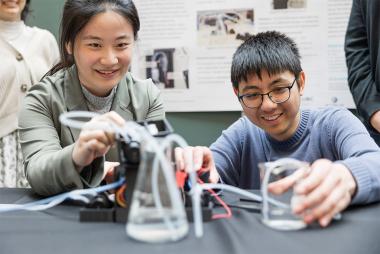UBC engineering researcher lifting virus detection to next level

August 8, 2023
Researchers from the University of British Columbia and Michigan State University (MSU) have invented a system that can quickly and inexpensively detect airborne viruses using the same technology that enables high-speed trains.
The team showed that a technique known as magnetic levitation can be used to easily collect and concentrate viruses from air to help prevent future outbreaks of respiratory disease. The researchers published their work in the journal ACS Nano.
“This could help identify that an environment is contaminated before a pandemic happens,” said Dr. Sepideh Pakpour, an assistant professor of engineering who led the research team at the UBC Okanagan School of Engineering.
In addition to serving as an early-warning system, the team’s new technique also could help health officials and epidemiologists better track and trace exposure to viruses in public settings.
“It’s very important to have real-time management and real-time predictions in place for viruses,” said Dr. Morteza Mahmoudi, an associate professor in the department of radiology and the Precision Health Program at MSU. “What we’ve developed is a system that could help us and other stakeholders get more information about the different types of viruses in the air we breathe.”
Pakpour and Mahmoudi started this project by applying magnetic levitation, or maglev, to respiratory viruses in 2018 with support from the Walsh Foundation and the New Frontiers in Research Fund.
As they learned the pandemic was caused by an airborne virus, they knew they had to redouble their efforts. The team used a deactivated version of the coronavirus responsible for COVID-19 in their proof-of-concept report, along with H1N1 influenza and a virus that infects bacteria known as bacteriophage MS2.
The system first collects air samples, then injects the sample into a fluid where maglev separates viruses from other particles. The isolated and purified viral contents are then passed along to other standard analytical techniques for identification in a matter of minutes. The approach is so straightforward that it could be used by nonexperts in a variety of settings such as clinics and airports, the researchers say.
The team is now taking the first steps toward commercializing its technology while working to improve it at the same time.
Although downstream techniques can identify which viruses are in a sample, one of the team’s future goals is refining the maglev step to distinguish between different viruses on its own. The researchers also are working to heighten their technique’s sensitivity and detect viruses in air at lower concentrations.
Still, the team is excited by what it was able to accomplish in its initial work and by what it may enable other researchers to do.
“Using maglev for disease detection and purifying viruses is brand new, and it could open up applications in many different fields,” said Mahmoudi. “This opens up a fundamentally new direction in analytical biochemistry.”


